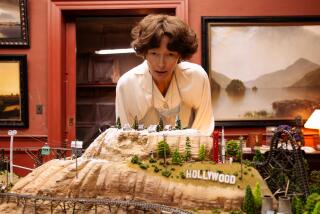The Auteur Who Coined the Word : Commentary: A Jean Renoir expert says UCLA’s retrospective attempts to answer age-old questions about art.
- Share via
Long before any director with the right agent could get his name in a special box on the billboard, Jean Renoir was considered to be one of a handful of filmmakers whose artistic stamp could be found everywhere in their work. Renoir himself called such directors auteurs , directors who wrote their own scripts. But the term was later expanded to identify those directors whose personal vision could overcome the fragmentations of a collaborative art.
Whatever the status of the auteur theory as a way of determining cinematic value, the passionate commitment to the work of individual directors argued in the 1950s by Andre Bazin and such critics-into-filmmakers as Francois Truffaut and Jean-Luc Godard helped create an argument for the importance of film as a major art form based on the existence of major artists.
In that argument Renoir’s films were central. A new postwar film audience was awakening to the work of Truffaut, Goddard, Antonioni, Rossellini, Fellini and Bergman, and it was Renoir’s “La Grande Illusion” (1937) and “La Regle de Jeu” (“The Rules of the Game,” 1939) that first stirred a good part of that audience to believe that there was a particularly cinematic complexity of ideas, performances and imagery worth comparing to the established arts.
Time was that anyone living in a big city or college town could get an education in film history by just going to the local film society or repertory theater. Now, only in retrospectives like one that begins at UCLA today do we get a chance to ask those old questions about the shape of a director’s career and the value of individual works: What lasts? What do we still watch with pleasure, interest and even illumination?
Renoir was born in 1894, the second son of Impressionist painter Pierre-Auguste Renoir. His older brother Pierre became an actor and appears in Jean’s “La Nuit du Carrefour” (1932) as Simenon’s Inspector Maigret, in “Madame Bovary” (1934) as Charles Bovary and in “La Marseillaise” (1938) as Louis XVI. Pierre’s son Claude worked as a cinematographer on several of Jean’s films from the mid-1930s onward.
UCLA’s centenaire focuses on Renoir’s career to 1939, when the filmmaker immigrated to the United States, settling in Beverly Hills and making five more films during World War II. A film enthusiast whose childhood interest had been reawakened by an enforced period of recuperation from a war wound, Renoir in the early 1920s produced and wrote the script for “Catherine” (1924), starring his wife, Catherine Hessling, who had been one of his father’s models. It was directed by Albert Dieudonne, later the star of Abel Gance’s epic “Napoleon” (1927).
*
But Renoir was disappointed with what Dieudonne had done. He gave up a career as a ceramicist and sold several of his father’s paintings to finance his first feature, “La Fille de l’Eau” (1924), the story of a young girl (again played by Hessling) who lives on a barge with her brutal uncle. (The only painting he kept was a large one depicting himself dressed as a hunter. It now hangs in the Los Angeles County Museum of Art.)
Between “La Fille de l’Eau” and “Rules of the Game,” Renoir made 18 features and several shorter films, including the “long shorts” “La Petite Marchande aux Allumettes” (“The Little Match Girl,” 1928), “On Purge Bebe” (1931) and “Partie de Campagne” (“A Day in the Country,” 1936, completed in 1946). With the exception of “Rules of the Game” and “Grande Illusion,” the films of this period are rarely shown, and the UCLA programmers have included virtually everything Renoir made, with the exception of the lost feature “Marguita” and the lost short “Le Petit Chaperon Rouge” (“Little Red Riding Hood”).
“On Purge Bebe” and “Chotard et Cie” (1933) are being shown for the first time in the United States, and many of the other films are being shown in Renoir’s own copies, willed to UCLA. These include “Le Tournoi” (1929), a story of romance and politics set in the 16th-Century France of Catherine de Medicis, which was previously thought to exist only in a 10-minute fragment.
The tremendous variety of Renoir’s work in the 1920s and 1930s seems amazing today when a director is considered remarkably talented if he or she can work in two genres, and a genius if in three. Throughout his career Renoir was constantly experimenting with genres and styles, often within the same film. Equally fascinated by stylized sets and location shooting, he freely mingled artifice and realism in both his plots and his images.
The general impression of the benevolence of Renoir’s films may be due to associating them with the dappled, rosy nudes of his father’s paintings. But there is little here of Pierre-Auguste Renoir’s frequent blandness and prettification. These films of the 1920s and 1930s, in both subject matter and pictorial style, more resemble the harsh urban interiors of Toulouse-Lautrec or the shimmering uncertainties of Monet’s gardens.
“La Fille de l’Eau” marks the beginning of a silent-film career that included adaptations of Zola’s “Nana” (also starring Hessling), “Le Tournoi” and “Le Bled,” an innocently imperialist paean to the settlement of Algeria. By the end of the ‘20s, however, these films in the lavish silent style (perhaps in emulation of his early idol Erich von Stroheim) had given Renoir a reputation for being an expensive filmmaker.
*
In 1931 with “On Purge Bebe,” an adaptation of a Feydeau farce, Renoir became one of the few French directors to make the silent-to-sound transition by proving he could make a film cheaply and quickly (five weeks from scriptwriting to breaking even), while outrageously exploiting the new technology (the first toilet flushing on a soundtrack).
Despite his commitment to the auteur director, Renoir was equally fascinated with the energy and movement of performers, and his camera itself increasingly plays the role of an observer within the scene rather than a God-like eye above it, even in epic works like “Le Tournoi.”
He also acts, notably in “Rules of the Game,” and his films are filled with memorable faces and presences: Hessling in his early films; Valentine Tessler in “Madame Bovary”; Charles Blavette in “Toni” (1935); Jean Gabin in “Grande Illusion,” “The Lower Depths” and “La Bete Humaine” (1938); Marcel Dalio in “Grande Illusion” and “Rules of the Game” and, perhaps most strikingly, Michel Simon in “Boudu Saved From Drowning” (1932), which Renoir called “a kind of free exercise around an actor,” and on which Paul Mazursky based “Down and Out in Beverly Hills.”
Many of these films deal with people trapped by their own passions. “La Chienne” (1931), starring Simon as a meek clerk who kills his mistress, is a forerunner of the stories of betrayal that would preoccupy film noir 15 years later. “La Nuit du Carrefour” (1932) exploits even more the shadows, mists and water-slick streets of a detective thriller. “Toni’s” story of murder and desire, set among Italian laborers in the south of France, presages Italian neorealism and further underlines this strongly fatalistic streak, as does Renoir’s adaptation of Zola’s “La Bete Humaine.”
Both “La Bete” and “La Chienne” were later remade by Fritz Lang as “Human Desire” (1954) and “Scarlet Street” (1945). Similarly, Renoir’s version of Gorki’s “The Lower Depths” (1936) might be compared to Akira Kurosawa’s (1957)--rare opportunities to see how two great directors treat the same material.
But even in the films shadowed by an encroaching sense of doom, there is a vein of optimism about what the world would be like if other choices were possible. One of the most intriguing of Renoir’s films of the 1930s, “The Crime of M. Lange” (1935), bears his name not only as director but also as a member of a radical culture collective, the Groups Octobre. The compatriots behind the camera are mirrored in the story of a publishing house for which Lange writes tales about a hero named Arizona Jim and an American West he has never seen. When the conniving publisher seems to have died in a train wreck, the workers take over and become tremendously successful.
*
With the kind of creative prescience that Renoir shows in many other films of the period, Lange is an early version of the kind of the sometimes sardonic, sometimes affectionate view of popular culture that would inspire the directors of the New Wave. As in “La Vie est a Nous” (1936), a “March of Time”-like fiction documentary made as an anti-fascist recruiting film for the French Communist Party, Lange asserted the possibility of a collective moral response that still respected individual eccentricity and difference.
Similarly, in “La Marseillaise” (1938), Renoir views the French Revolution through its most famous song, as it evolves from a popular folk tune to become the national anthem. With comparable revolutionary optimism about film economics, the film was financed by two-franc contributions by members of the CGT, the French trade union.
UCLA’s showings conclude with “Rules of the Game,” which opened in 1939 to ferocious attacks by French fascist groups. Re-editing was fruitless, and the film was later banned by the Vichy regime.
Renoir’s flight from Europe to America occurred not long after the release of “Rules of the Game,” and his later films have their own appeal. But the work of few directors of any period have the continuity and variety as Renoir’s from 1924 to 1939, and fewer still would reward anything like a complete submersion in the sun and shadow, the complex warmth of the world he makes entirely his own.
Braudy is a professor of English at USC and is the author of “Jean Renoir: The World of His Films” (Columbia University Press).
Renoir Retrospective
“Centenaire de Jean Renoir: 1924-1939,” a retrospective in honor of the 100th anniversary of his birth, continues at UCLA’s Melnitz Theater through Aug. 6.
Today, 8 p.m.: “Charleston,” “La Fille de l’Eau,” “Catherine.”
Saturday, 4 p.m.: “La Petite Marchande aux Allumettes” (“The Little Match Girl”), “Tire-au-Flanc.”
Saturday, 7:30 p.m.: “La Petite Lili,” “Nana.”
Sunday, 7 p.m.: “Le Tournoi,” “Le Bled.”
Thursday, 7:30 p.m.: “La Chienne,” “La Nuit de Carrefour.”
July 23, 7:30 p.m.: “On Purge Bebe,” “Boudu Sauve des Eaux” (“Boudu Saved From Drowning”), “Chotard et Cie.”
July 24, 7 p.m.: “Madame Bovary,” “Toni.”
July 26, 7:30 p.m. “Une Partie de Campagne” (“A Day in the Country”), “Les Bas-Fonds” (“The Lower Depths”).
July 29, 7:30 p.m.: “Le Crime de M. Lange,” “La Vie est a Nous.”
Aug. 5, 7:30 p.m.: “La Grande Illusion,” “La Marseillaise.”
Aug. 6, 7:30 p.m.: “La Bete Humaine,” “La Regle du Jeu” (“The Rules of the Game”).
* UCLA’s Melnitz Theater is on the northeast corner of the Westwood campus, near Sunset Boulevard and Hilgard Avenue. Tickets are $5 general admission and $3 for students and senior citizens. Parking is available in UCLA Lot 3 for $5. Information: (310) 206-FILM. Synopses or captions will be available for those few films without English translation.
More to Read
The biggest entertainment stories
Get our big stories about Hollywood, film, television, music, arts, culture and more right in your inbox as soon as they publish.
You may occasionally receive promotional content from the Los Angeles Times.










